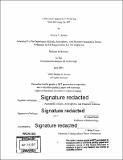| dc.contributor.advisor | R. Alan Plumb. | en_US |
| dc.contributor.author | Acosta, Wesley C. (Wesley Cordell) | en_US |
| dc.contributor.other | Massachusetts Institute of Technology. Department of Earth, Atmospheric, and Planetary Sciences. | en_US |
| dc.date.accessioned | 2018-03-12T19:30:13Z | |
| dc.date.available | 2018-03-12T19:30:13Z | |
| dc.date.copyright | 2003 | en_US |
| dc.date.issued | 2003 | en_US |
| dc.identifier.uri | http://hdl.handle.net/1721.1/114108 | |
| dc.description | Thesis: S.B., Massachusetts Institute of Technology, Department of Earth, Atmospheric, and Planetary Sciences, 2003. | en_US |
| dc.description | Cataloged from PDF version of thesis. Pages 15, 16 and 35 not in original thesis. | en_US |
| dc.description | Includes bibliographical references (pages 38-40). | en_US |
| dc.description.abstract | A snowfall potential probability density function is introduced that uses an alternate method of statistical analysis in predicting snowfall by using concepts of normal probability distributions. The snowfall potential function (hereby referred to as the SPF) assumes certain identifiers are associated with snowfall of varying intensities. The conceptual relation of each identifier with snowfall is explained and the statistical association of each identifier to the SPF is determined by a correlation coefficient and the relative strength of that particular identifier with respect to the expected value (the mean). The intensity of the snowfall over an area is estimated by calculating the SPF's overall deviation from some expected value, where any given SPF value can estimate a snowfall value. The framework for the SPF is explained using a simple model. The correlation coefficients for several identifiers are calculated and an example of an application of the SPF is demonstrated. Further hypotheses are given as to how the SPF could ultimately be used to provide possible higher-accuracy snowfall forecasts through the development of time-dependent functions for each identifier and the assigning of specific functional forms for the SPF based on region of analysis, storm type (i.e.: coastal, Alberta clipper), and storm track. 2 | en_US |
| dc.description.statementofresponsibility | by Wesley C. Acosta. | en_US |
| dc.format.extent | 40 pages | en_US |
| dc.language.iso | eng | en_US |
| dc.publisher | Massachusetts Institute of Technology | en_US |
| dc.rights | MIT theses are protected by copyright. They may be viewed, downloaded, or printed from this source but further reproduction or distribution in any format is prohibited without written permission. | en_US |
| dc.rights.uri | http://dspace.mit.edu/handle/1721.1/7582 | en_US |
| dc.subject | Earth, Atmospheric, and Planetary Sciences. | en_US |
| dc.title | A statistical approach to predicting snowfall using the SPF | en_US |
| dc.title.alternative | Statistical approach to predicting snowfall using the snowfall potential function | en_US |
| dc.type | Thesis | en_US |
| dc.description.degree | S.B. | en_US |
| dc.contributor.department | Massachusetts Institute of Technology. Department of Earth, Atmospheric, and Planetary Sciences | |
| dc.identifier.oclc | 1027478745 | en_US |
